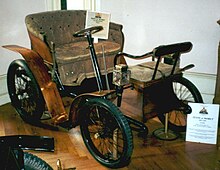Vis-à-vis (carriage): Difference between revisions
Guliolopez (talk | contribs) That's a lot of forced formatting.... |
No edit summary |
||
| Line 1: | Line 1: | ||
{{Short description|Four-wheeled horse-drawn vehicle}} |
|||
__NOTOC__ |
|||
{{use dmy dates|date=September 2023}} |
|||
[[File:2009-09-23 Vis a Vis Kutschenmuseum.jpg|thumb|right|Historical vis-à-vis carriage]] |
[[File:2009-09-23 Vis a Vis Kutschenmuseum.jpg|thumb|right|Historical vis-à-vis carriage]] |
||
A '''vis-à-vis''' is a [[carriage]] in which the passengers sit face to face with the front passengers facing rearward and the rear passengers facing forward.<ref name="Haajanen">{{cite book |last= Haajanen|first= Lennart W.|others= Illustrations by Bertil Nydén; foreword by [[Karl Ludvigsen]]|year= 2003|title= Illustrated Dictionary of Automobile Body Styles|location= Jefferson, NC USA|publisher= McFarland|isbn= 0-7864-1276-3|lccn= 2002014546|page=155}}</ref> The term comes from the [[French language|French]] ''vis-à-vis'', meaning face to face.<ref name="Haajanen"/><ref name="Beattie">{{cite book|last= Beattie|first= Ian|title= The Complete Book of Automobile Body Design|year= 1977|publisher= The Haynes Publishing Group|location= Yeovil, UK|isbn= 0854292179}}</ref>{{refpage|page=28}} |
A '''vis-à-vis''' is a [[carriage]] in which the passengers sit face to face with the front passengers facing rearward and the rear passengers facing forward.<ref name="Haajanen">{{cite book |last= Haajanen|first= Lennart W.|others= Illustrations by Bertil Nydén; foreword by [[Karl Ludvigsen]]|year= 2003|title= Illustrated Dictionary of Automobile Body Styles|location= Jefferson, NC USA|publisher= McFarland|isbn= 0-7864-1276-3|lccn= 2002014546|page=155}}</ref> The term comes from the [[French language|French]] ''vis-à-vis'', meaning face to face.<ref name="Haajanen"/><ref name="Beattie">{{cite book|last= Beattie|first= Ian|title= The Complete Book of Automobile Body Design|year= 1977|publisher= The Haynes Publishing Group|location= Yeovil, UK|isbn= 0854292179}}</ref>{{refpage|page=28}} |
||
| Line 19: | Line 20: | ||
== See also == |
== See also == |
||
{{Commons category|Vis-à-vis automobiles}} |
{{Commons category|Vis-à-vis automobiles}} |
||
* [[ |
* [[Horse-drawn vehicle]] |
||
* [[Car body styles]] |
* [[Car body styles]] |
||
| Line 25: | Line 26: | ||
{{Reflist}} |
{{Reflist}} |
||
{{Horse-drawn carriages|state=expanded}} |
|||
{{Automobile configuration}} |
{{Automobile configuration}} |
||
Latest revision as of 09:59, 26 September 2023

A vis-à-vis is a carriage in which the passengers sit face to face with the front passengers facing rearward and the rear passengers facing forward.[1] The term comes from the French vis-à-vis, meaning face to face.[1][2]: 28
These carriages are still commonly made by Amish carriage makers in the midwestern United States.[citation needed] Also in the Western world, the vis-a-vis is the most common type of carriage style used to cart tourists and leisure seekers in downtown urban settings.
Passengers sit back-to-back on dos-à-dos carriages.
Examples[edit]
The following types of carriage had vis-à-vis seating:
Automobiles[edit]

There were vis-à-vis automobiles in the early history of motoring.[2]: 28 These were driven from the forward-facing rear seat, with front passengers sitting ahead of the steering controls and facing the driver.[1][2]: 28 [3] Passengers in the front seat would obstruct the vision of the driver in the rear seat, and the style fell out of favour before 1905.[1][2]: 27-28
See also[edit]
References[edit]
- ^ a b c d Haajanen, Lennart W. (2003). Illustrated Dictionary of Automobile Body Styles. Illustrations by Bertil Nydén; foreword by Karl Ludvigsen. Jefferson, NC USA: McFarland. p. 155. ISBN 0-7864-1276-3. LCCN 2002014546.
- ^ a b c d Beattie, Ian (1977). The Complete Book of Automobile Body Design. Yeovil, UK: The Haynes Publishing Group. ISBN 0854292179.
- ^ Culshaw, David; Horrobin, Peter (2013) [1974]. "Appendix 5: Coachwork Styles". The Complete Catalogue of British Cars 1895 - 1975 (e-book ed.). Poundbury, Dorchester, UK: Veloce Publishing. pp. 480–484. ISBN 978-1-845845-83-4. |page=484
